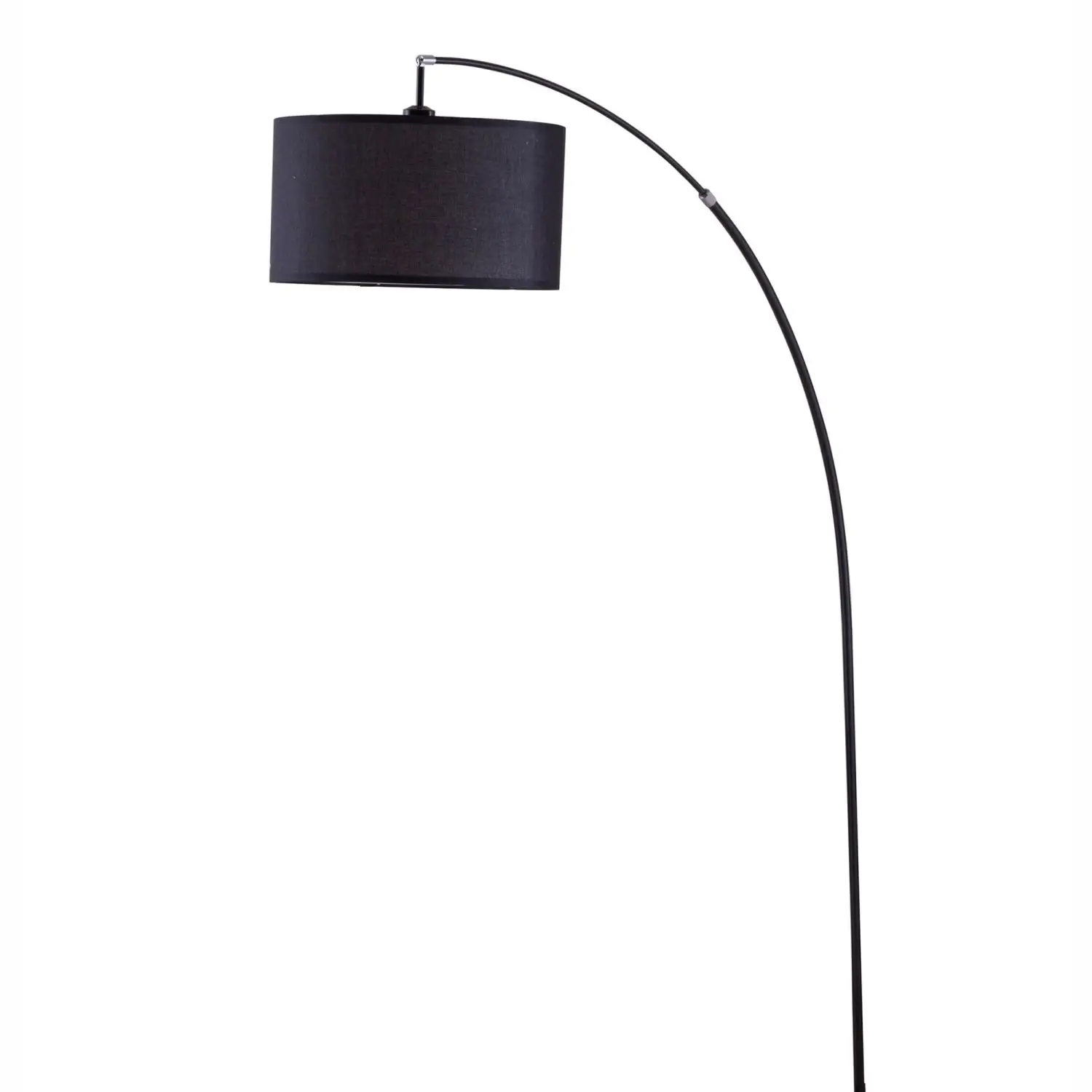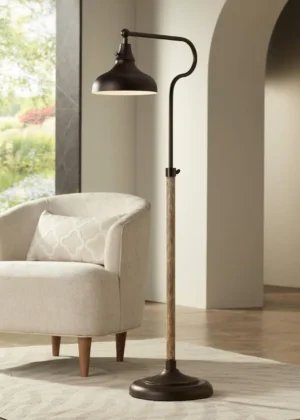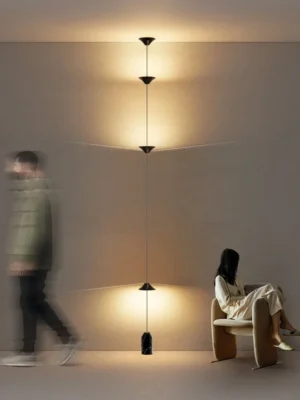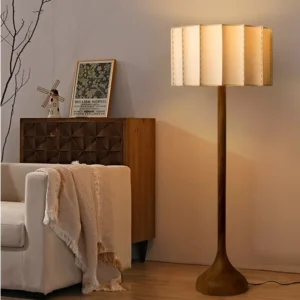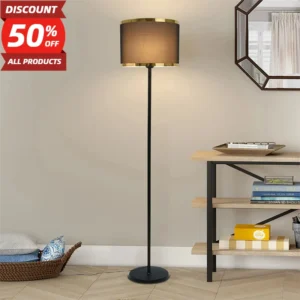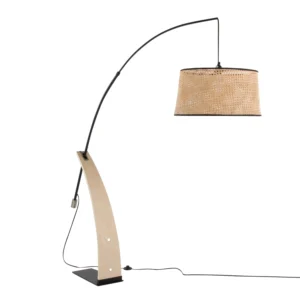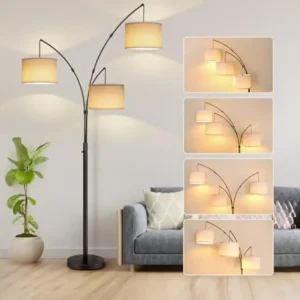The Unexpected Advantage: Why Arc Lamps Excel in Small Spaces
Arc floor lamps, with their distinctive curved stem extending outward from a weighted base, are often misunderstood as fixtures exclusively for spacious rooms. This common misconception stems from their dramatic silhouette and sweeping design. However, the truth reveals quite the opposite: arc lamps can be ideal solutions for compact living environments.
Unlike traditional floor lamps that require substantial floor space directly beneath the light source, arc lamps allow you to position the base away from the area you want to illuminate. This unique design feature creates several advantages for small spaces:
- The base can be tucked into corners or behind furniture while the light extends over seating areas
- The arched design minimizes the lamp’s footprint while maximizing its lighting reach
- The elevated light source distributes illumination more evenly throughout compact rooms
The clever construction of modern arc lamps means they can deliver overhead lighting without requiring ceiling fixtures—particularly valuable in rental properties or rooms where electrical modifications aren’t feasible. The process of choosing the perfect arc floor lamp becomes especially important when working with spatial constraints.
What makes arc lamps particularly suitable for small spaces is their ability to combine form with function. Their sleek profiles create visual interest without the bulkiness of conventional lighting options. Many minimalist arc floor lamp designs specifically address compact living challenges through thoughtful proportions and space-conscious engineering.
When strategically positioned, these statement pieces can transform cramped quarters into well-lit, visually expansive environments—proving that sometimes the best solutions for small spaces come in unexpected forms.
Four Key Benefits of Arc Lamps in Compact Rooms
- Overhead Illumination Without Installation
Arc lamps provide ceiling-like lighting without requiring any electrical work or permanent fixtures. This makes them perfect for renters or anyone who wants to avoid drilling holes. The arched design positions light from above, creating that coveted overhead illumination while eliminating the need for ceiling-mounted fixtures. This benefit is particularly valuable in apartments with low ceilings or where electrical modifications are prohibited.
- Space-Saving Design
The genius of arc lamps lies in their ability to separate the light source from the base. Traditional floor lamps require valuable floor space directly beneath where you need light, often competing with furniture. Arc lamps, however, allow you to place the base in a less central location while extending light exactly where you need it. This design means you can tuck the base behind a sofa or in a corner, freeing up precious floor space in tight quarters.
- Versatile Lighting Functions
A single arc lamp can fulfill multiple lighting needs in a compact room. Positioned correctly, it can provide ambient room lighting, focused task lighting for reading or working, and even accent lighting to highlight décor—all from one fixture. The overall benefits of arc floor lamps become particularly evident in small spaces where multi-functional solutions are essential. Adjustable models offer even more flexibility, allowing you to direct light as needed for different activities.
- Visual Space Enhancement
Arc lamps draw the eye upward with their vertical presence and suspended light source. This visual journey creates an illusion of height and space in rooms with limited square footage. By establishing a vertical line in your design scheme, these lamps counterbalance the horizontal planes of furniture, making ceilings appear higher and rooms feel larger than they actually are. This architectural trick is especially valuable in studio apartments or rooms with low ceilings.
Selecting the Perfect Arc Lamp for Small Rooms: Size and Scale Considerations
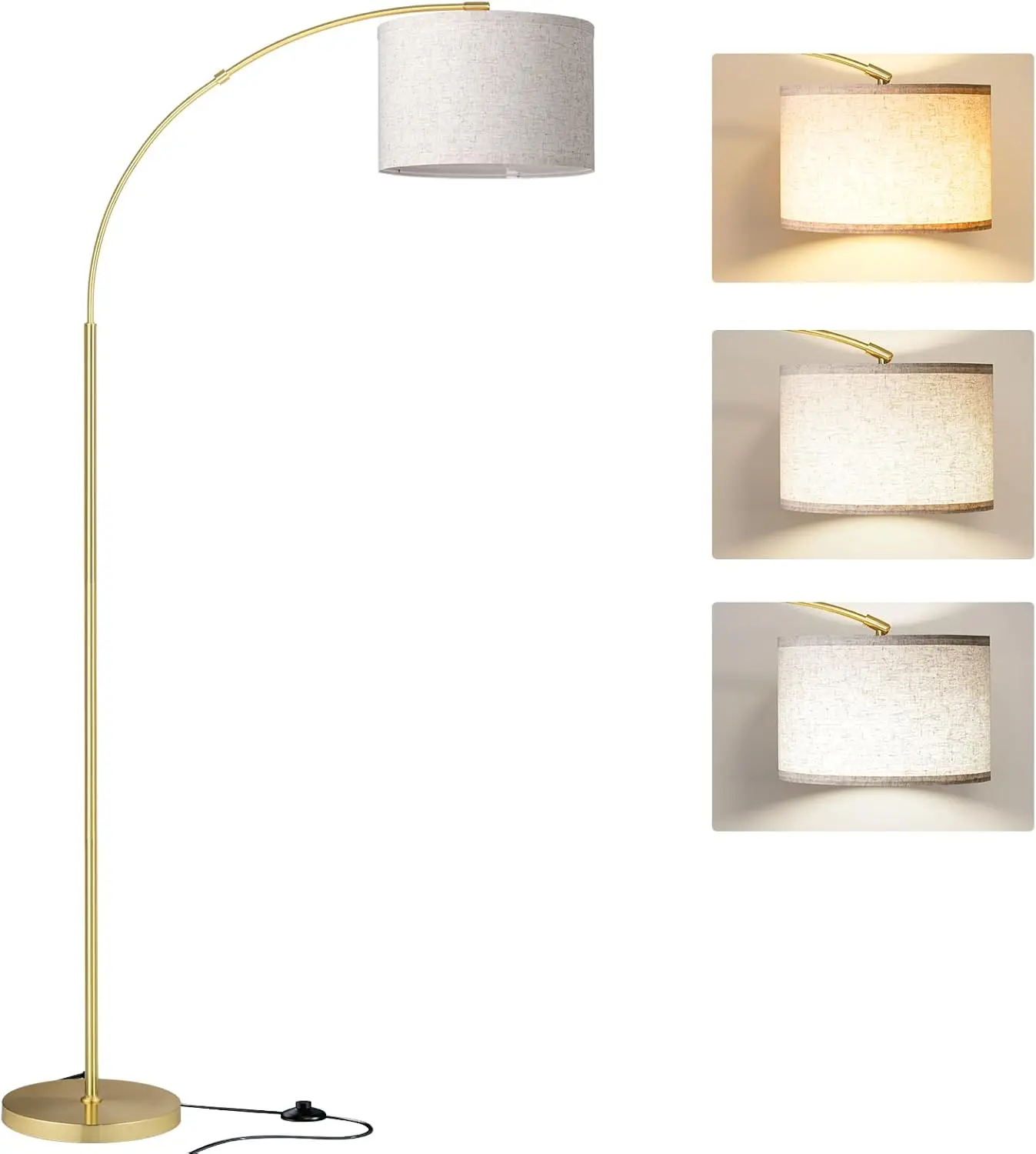
Finding the right balance between impact and proportion is crucial when selecting an arc lamp for a compact space. The key is understanding how the lamp’s dimensions will interact with your room’s measurements and existing furnishings.
When evaluating arc lamps for small spaces, pay careful attention to these critical measurements:
- Total height: Most arc lamps range from 60-84 inches tall. For rooms with 8-foot ceilings, look for models under 75 inches to maintain proper proportion.
- Arc reach: This measures how far the light extends horizontally from the base. For rooms under 150 square feet, consider arcs between 30-45 inches rather than more dramatic 60-inch reaches.
- Base diameter: Bases typically range from 8-14 inches. In compact spaces, look for bases under 10 inches that provide stability without dominating floor space.
For truly tiny spaces (like 8×10 foot rooms), consider selecting an arc lamp with a height under 70 inches and an arc reach of 30-40 inches. For slightly larger small rooms (12×12 feet), you can accommodate lamps with heights up to 75 inches and reaches up to 45 inches without overwhelming the space.
A helpful rule of thumb: the lamp should occupy no more than 5% of your room’s total square footage when considering its footprint and overhead presence. Understanding the perfect arc floor lamp height for your specific space helps ensure proper proportions and adequate clearance.
Before purchasing, map out the lamp’s dimensions in your room using masking tape on the floor or by placing a box where the base would sit and holding a yardstick to visualize the arc. This simple exercise can prevent investing in a lamp that overwhelms your space or interferes with traffic flow.
Design Features That Matter: Choosing Small-Space Friendly Arc Lamp Styles
When selecting an arc lamp for a compact room, certain design elements can make a significant difference in how well the piece integrates into your space:
Slim Profiles: Look for lamps with slender stems rather than chunky or ornate posts. A thin, streamlined silhouette minimizes visual weight and prevents the lamp from dominating the room. Minimalist construction with clean lines creates presence without overwhelming small spaces.
Base Considerations: Weighted, low-profile bases provide stability while maintaining a modest footprint. Some innovative designs feature bases that can slide under furniture, further reducing their space impact. An 8-10 inch diameter base typically balances stability with space efficiency.
Shade Design: Compact, proportional shades work best in small rooms. Consider transparent or translucent materials that allow light to pass through, creating less visual density. Adjustable shades offer flexibility for directing light exactly where needed without repositioning the entire fixture.
Material and Finish: Different materials significantly affect how substantial a lamp appears in your space. Glass or acrylic components create lightness and transparency, while heavy fabric shades can make the lamp feel more imposing. Reflective metal finishes often visually recede more than matte black or dark wood elements.
Color Coordination: Choose finishes that either blend seamlessly with your room’s palette for a cohesive look or complement it with intentional contrast. Matching metallic finishes to existing hardware creates cohesion, while selecting colors similar to your walls can help the lamp integrate more subtly.
The most effective small-space adjustable arc floor lamp options combine these elements with flexibility features that allow you to modify the light position as needed. This adaptability ensures the lamp remains functional even as your furniture arrangement or needs change over time.
Strategic Placement: Five Optimal Positions for Arc Lamps in Small Layouts
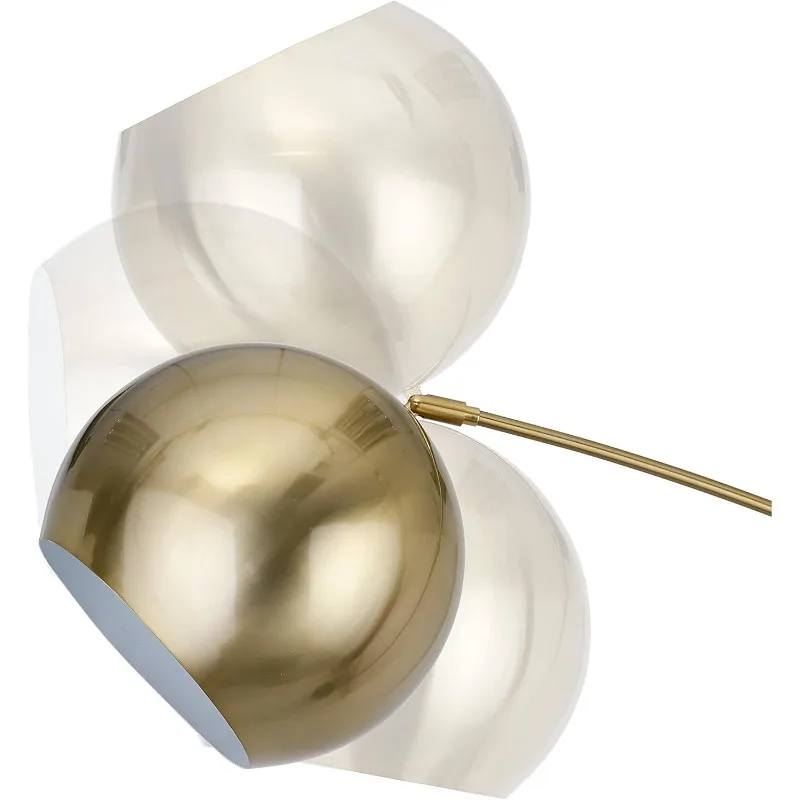
- Behind Seating
Positioning an arc lamp behind a sofa, loveseat, or armchair is perhaps the most space-efficient placement strategy. The base tucks neatly behind the furniture while the arc extends the light source over your seating area. This approach maximizes usable floor space while providing directed light exactly where it’s needed. For optimal positioning, place the base 6-8 inches from the wall and adjust the arc to suspend the light 24-30 inches above the seating surface. This technique for pairing arc lamps with sofas creates a cohesive lighting solution without consuming valuable open floor space.
- Corner Optimization
Corners are often underutilized in small rooms, making them perfect locations for arc lamp bases. From a corner position, the lamp’s reach can extend over adjacent seating areas or workspaces. This placement maximizes the lamp’s functional coverage while keeping the base in a low-traffic area. For best results, position the base 3-4 inches from each wall, allowing the arc to project diagonally across the corner toward your focal point.
- Reading and Task Areas
Create functional activity zones without additional furniture by positioning an arc lamp to define reading nooks or work areas. Unlike table lamps that require surface space, arc lamps provide focused illumination while leaving tables, desks, or console surfaces completely free. For reading areas, adjust the light to fall approximately 18 inches from your shoulder at a height that prevents glare on reading materials.
- Window-Adjacent Placement
Placing an arc lamp near a window complements natural light during the day while providing illumination after dark. This strategic positioning maintains an open feel by grouping light sources together rather than cluttering the room with multiple fixture locations. During daylight hours, the lamp’s silhouette creates an interesting architectural element against the natural backdrop.
- Traffic Flow Considerations
In tight spaces, ensuring the arc lamp doesn’t obstruct movement is essential. Position the base away from walkways while allowing the arc to extend over stationary areas like seating or tables. Maintain a clearance of 18-24 inches above head height for anyone walking beneath the arc. Creating a deliberate pathway around the lamp prevents it from becoming an obstacle in daily navigation.
Practical Solutions: Overcoming Common Arc Lamp Challenges in Small Spaces
Safety Concerns
Tripping hazards pose a legitimate concern when adding any floor lamp to a compact layout. Address this by positioning the lamp’s base against walls or furniture rather than in open floor areas. Consider cord management solutions like clear cord covers or decorative cord concealers that attach to baseboards. Some users successfully hide cords under area rugs—just ensure they follow straight paths to prevent creating bumps or tripping points.
Visual Balance
Even in small rooms, an arc lamp shouldn’t feel overwhelming. If your lamp seems visually dominant, try balancing it with another vertical element on the opposite side of the room, such as a tall plant or bookshelf. Position the lamp where it visually “makes sense” within your layout—usually near seating areas where its function is obvious. Black arc floor lamp options often provide versatile neutral styling that integrates more easily with existing décor.
Stability Issues
Small spaces often experience more movement and traffic, making lamp stability crucial. Look for models with substantial weighted bases or low centers of gravity. If your lamp feels slightly unstable, consider adding non-slip furniture pads beneath the base to enhance grip on smooth flooring. In homes with children or pets, positioning the base where it’s partially blocked by furniture provides additional security against accidental bumps.
Lighting Coverage
Ensuring adequate illumination without harsh contrasts requires thoughtful adjustment. Position your arc lamp to complement existing light sources rather than fighting them. Adjust the height and angle to avoid creating strong shadows or glare spots. For reading or task areas, the light source should be positioned at approximately a 30-45 degree angle from your activity to minimize shadows from your own movements.
Design Impact: How Arc Lamps Transform Small Room Aesthetics
Arc lamps possess a remarkable ability to elevate the design of compact spaces beyond their practical lighting functions. By introducing a strong vertical element with an elegant curve, these fixtures create architectural interest in rooms where horizontal space is limited. This upward visual movement counteracts the compressed feeling often experienced in smaller environments.
When used as statement pieces, arc lamps add sophisticated focal points without consuming valuable surface area. Unlike bulky table lamps or imposing ceiling fixtures, the delicate silhouette of an arc lamp makes a design statement through elegant proportion rather than substantial mass. This subtle approach to statement lighting works particularly well in minimalist or contemporary small spaces.
The interplay of light and shadow created by arc lamps adds dimension to compact rooms. The directional nature of the light source creates gentle gradients of illumination that enhance depth perception, making the space feel larger and more dynamic. This lighting technique is especially effective in the evening hours, when the lamp becomes the primary light source and can dramatically transform spatial perception.
Color and material coordination becomes particularly important in small spaces where every element is visible simultaneously. An arc lamp with metallic elements that echo other fixtures in the room creates cohesion, while thoughtfully selected shade materials complement existing textiles. How modern arc lamps transform living room environments is particularly evident in small spaces, where their impact is magnified by the intimate scale.
By introducing curved lines in predominantly rectangular spaces, arc lamps soften the overall feel of the room. This subtle counterpoint to standard architectural elements adds visual interest and creates a more welcoming atmosphere in what might otherwise feel like a boxy, confined space.
Comparative Advantage: Arc Lamps vs. Other Small Space Lighting Options
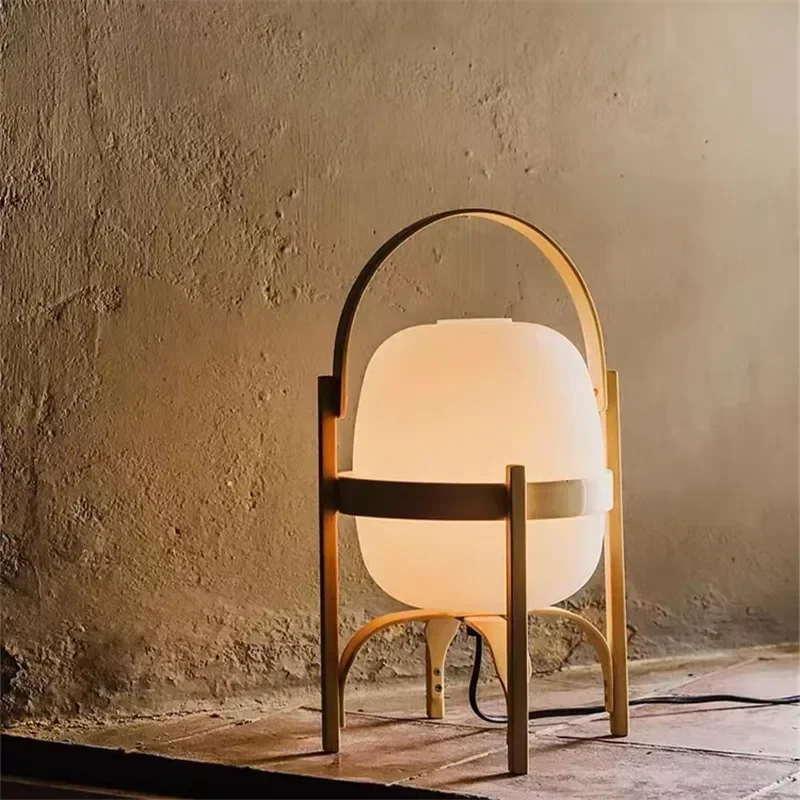
When evaluating lighting options for compact spaces, understanding how arc lamps compare to alternatives helps determine the most suitable solution for your specific needs.
Arc Lamps vs. Traditional Floor Lamps
Arc lamps require less central floor space than traditional floor lamps since their base can be positioned away from the area being illuminated. While a standard floor lamp needs approximately 1-2 square feet of floor space directly where light is needed, an arc lamp’s footprint can be tucked into corners or behind furniture. Traditional floor lamps typically provide more focused downward light, while arc lamps offer broader coverage from above, more closely mimicking natural lighting patterns.
Arc Lamps vs. Table Lamps
The most significant advantage arc lamps have over table lamps in small spaces is that they eliminate the need for surface space. Table lamps require both a table and 0.5-1 square foot of its surface, reducing available space for other functions. Arc lamps provide equivalent or superior illumination without consuming valuable horizontal surfaces that could otherwise be used for practical purposes or kept clear to enhance spaciousness.
Arc Lamps vs. Wall Sconces
While wall sconces offer excellent space efficiency, they require permanent installation with electrical work, making them impractical for renters or those wanting flexibility. Arc lamps provide similar space-saving benefits with the added advantage of repositioning capability. Sconces typically provide more ambient than task lighting, whereas arc lamps can effectively serve both functions depending on their positioning and shade design.
Adjustable Arc Floor Lamp, Bronze Arc Floor Lamp
Price range: $440.95 through $558.52 Select options This product has multiple variants. The options may be chosen on the product pageBlack Arc Floor Lamp, Contemporary Arc Floor Lamp
Price range: $277.34 through $458.46 Select options This product has multiple variants. The options may be chosen on the product pageMinimalist Arc Floor Lamp, Wood Arc Floor Lamp
Price range: $366.32 through $1,008.61 Select options This product has multiple variants. The options may be chosen on the product page- Price range: $250.89 through $369.85 Select options This product has multiple variants. The options may be chosen on the product page
Black Arc Floor Lamp, Mid-Century Arc Floor Lamp, Rattan Arc Floor Lamp, Wood Arc Floor Lamp
$963.46 Select options This product has multiple variants. The options may be chosen on the product page3 Light Arc Floor Lamp, Adjustable Arc Floor Lamp, Black Arc Floor Lamp, Contemporary Arc Floor Lamp, LED Arc Floor Lamp
$366.96 Select options This product has multiple variants. The options may be chosen on the product page
Arc Lamps vs. Pendant Lights
Like wall sconces, pendant lights require permanent ceiling installation and hardwiring. Arc lamps deliver a similar overhead lighting effect without structural modifications or electrical work. Pendants offer limited repositioning options once installed, while arc lamps—particularly adjustable arc lamp models with key features—can be reconfigured as needs change. For renters or those who enjoy regularly refreshing their space, this flexibility represents a significant advantage.
The ideal choice ultimately depends on your specific constraints, but arc lamps offer a unique combination of space efficiency, flexibility, and design impact that makes them particularly well-suited for small room challenges.
Frequently Asked Questions About Arc Lamps in Small Spaces
Can arc lamps work in rooms under 100 square feet?
Yes, arc lamps can work effectively in very small rooms under 100 square feet, but proper selection is crucial. Look for models with modest dimensions—ideally with heights under 70 inches and arc reaches between 30-40 inches. Positioning becomes even more important in tiny spaces; corner placement or behind-sofa arrangements maximize efficiency.
What defines a ‘small-space friendly’ arc lamp?
A small-space friendly arc lamp typically features a compact base (under 10 inches diameter), a slender stem, moderate height (under 75 inches), proportional arc reach (30-45 inches), and adjustable components. The most space-efficient models often incorporate transparent or minimalist shade designs and slim profiles that maintain visual lightness while providing functional illumination.
What types of arc lamps work best in different small room layouts?
For narrow rectangular rooms, consider arc lamps with longer, more dramatic reaches that can span from walls to central areas. In square rooms, more compact arcs with adjustable heights work well. Studio apartments benefit from multi-directional or adjustable arc lamps that can serve different areas as needed. Small bedrooms often work best with shorter arc designs positioned in corners to illuminate both the bed and adjacent areas.
How do adjustable arc lamps compare to fixed designs in small spaces?
Adjustable arc lamps offer superior versatility in small spaces, allowing you to modify light direction, height, and reach as activities change. This flexibility comes at a slightly higher price point and occasionally more mechanical complexity. Fixed arc designs often feature cleaner, more streamlined silhouettes but require more careful initial placement since their lighting position cannot be altered. For most small spaces, the adaptability of adjustable models makes them worth the investment, particularly in multi-purpose rooms where lighting needs frequently change.
Creating effective lighting in small spaces requires thoughtful consideration of both function and aesthetics. The complete guide to perfect lighting provides additional context for developing comprehensive lighting plans for compact environments that balance ambiance with practical needs.

